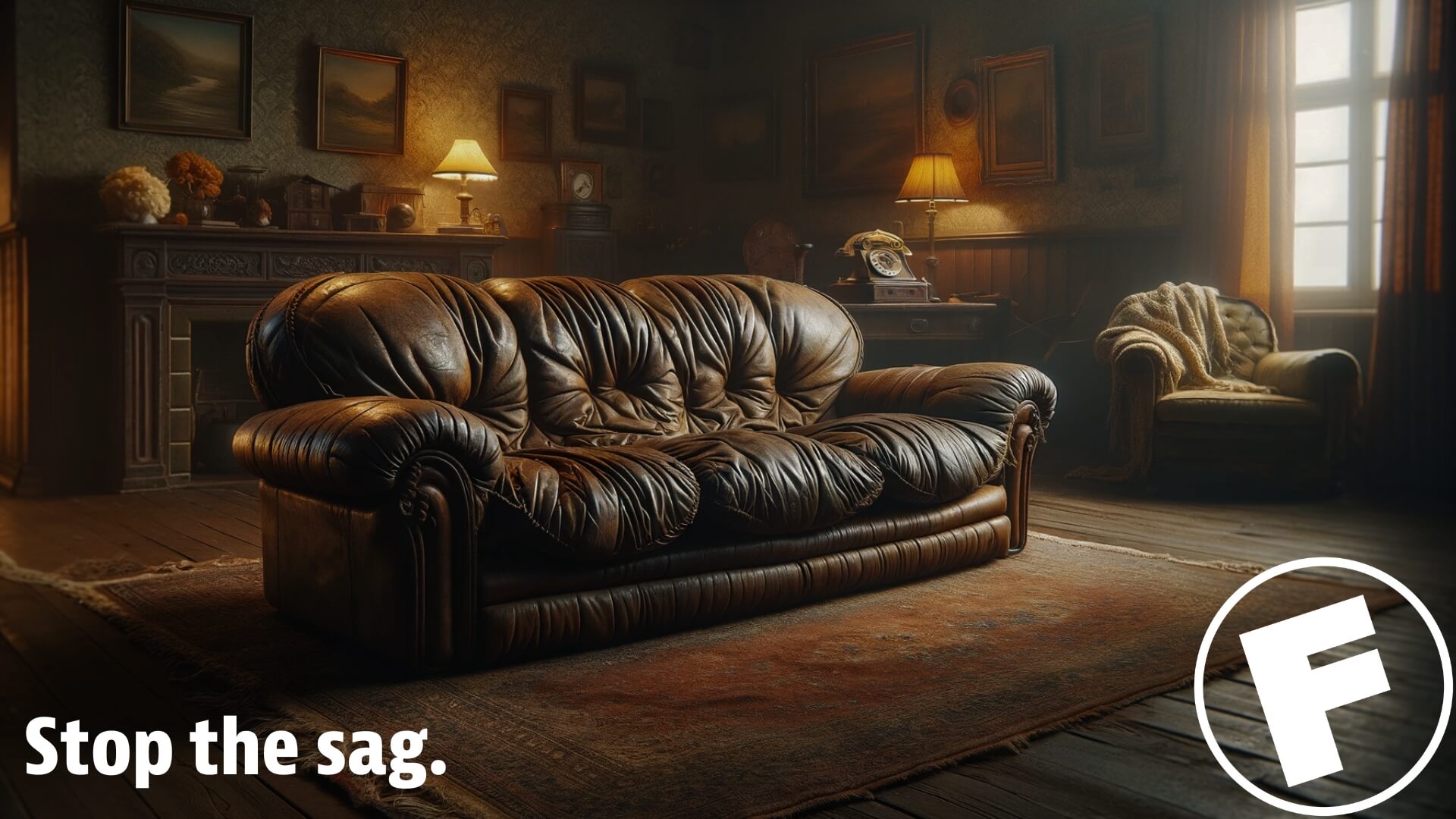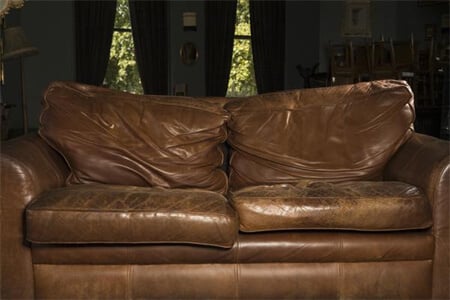Why Leather Couches Sag and How to Prevent It
At some point or another, I’m sure you’ve seen a leather sofa with a big, sagging indention in the owner’s favorite spot. Perhaps it is your own leather upholstery that is suffering such a fate.
Want to be sure your furniture never looks like that? Here’s some easy info on why it happens and what to do to prevent it. We’ve also included what to do if your leather couch or chair is already sagging.

Why the sagging on my leather couch?
The main cause of leather sagging is that the material isn’t getting the support it needs from the furniture’s foam seat cushions. Leather stretches naturally, so it needs a firm foam base to support people’s weight without sagging.
Stretching can also be affected by the thickness of the leather hide used and by whether or not the tannery stretched it well before they put it on the furniture. Just as fabric should be washed before sewing, so should leather be adequately treated to prevent additional stretching on sofa cushions.
Aside from leather quality and fit, there are actually many other reasons why your leather couch cushions might sag, as well:
- Subpar Frame Construction: The frame of a couch provides its structural support. If the frame is not well-built or if it’s made from low-quality materials, it can weaken and lead to sagging.
- Cushion Material and Density: The cushions in a leather couch play a crucial role in its comfort and durability. Over time, the cushioning material may lose its resilience, causing the couch to sag. Low-density foam or padding may deteriorate more quickly.
- Spring System: Many couches have springs in the seat cushions or suspension system to provide support and comfort. If these springs become damaged or lose their tension, the couch can sag.
- Usage: How a leather couch is used can contribute to sagging. Excessive weight or repeated heavy use, such as jumping or sitting on the edges of the cushions, can accelerate sagging.
- Moisture and Heat: Leather is sensitive to changes in moisture and temperature. Exposure to high humidity or direct sunlight can cause leather to lose its shape and sag over time.
- Maintenance: Proper maintenance can help extend the life of a leather couch. Regular cleaning and conditioning of the leather can prevent it from becoming dry and brittle, which can lead to sagging.
- Age: Like all furniture, leather couches will naturally wear with age. Over time, the materials used in the couch may break down, leading to sagging.
To prevent or minimize sagging in a leather couch, it’s important to invest in a high-quality couch, use it gently, and perform regular maintenance.
If your leather couch has already started to sag, you may want to consider getting it professionally repaired or reupholstered to restore its comfort and appearance. Your local Fibrenew operator will be happy to rescue your treasured couch!
How to avoid sagging leather seats
Here are some practical DIY methods for preventing that pesky sag.

Before you buy:
- It’s a good idea to buy couches and love seats that have several same-sized, removable cushions so you can switch them around periodically. That way, the cushions are worn more evenly, and your favorite spot won’t start to sag as quickly.
- The denser the foam is in the leather furniture you buy, the longer it will last before it starts to sag. So, if you prefer stiff-looking leather, you might want to go in that direction. However, keep in mind that many people think furniture with squishy foam is more comfortable than furniture with firm foam. You have to find a balance and consider your own priorities. This video gives a great explanation of restuffing a sagging leather couch.
- Is more expensive furniture better? Unfortunately, the answer to that question has to be frustratingly vague. More expensive leather is pretty much guaranteed to have nicer, better-made leather. But, more expensive leather does not necessarily have nicer foam. Some high-end furniture retailers ensure that every part of their furniture is top quality, and other cut costs on foam. Keep in mind that some high-quality leather furniture is intentionally made to be very soft, squishy, and comfortable. So, even though you pay the high dollar for a nice piece of furniture, choosing the comfy, squishy foam may mean that you still end up with a moderately sagging couch down the road.
Once you’ve got it:
The best thing you can do to avoid sagging seats is to distribute the use. If you have furniture with cushions you can move, switch them out every couple of months. If you don’t, try not to sit in the same place all the time.
Remember to always take care of your leather, too!
What to do:
If your leather furniture is already sagging, your best bet is to get new filling put in. The cost will vary depending on the size of the furniture and the extent of the problem.
Contact a Fibrenew professional to remedy any issues with your beloved leather couch. Until next time!
Why is my leather couch sagging? Leather couches can become saggy over time due to factors such as subpar frame construction, cushion material degradation, issues with the spring system, low-quality leather, heavy usage, and environmental factors like humidity and heat. Can sagging leather couches be repaired? Yes, sagging leather couches can often be repaired. Depending on the extent of the sagging, you may need to address issues with the frame, replace or add support to the cushions, or have the leather reupholstered. It’s best to consult with a professional Fibrenew furniture repair specialist. How can I prevent my leather couch from sagging? To prevent sagging, invest in a high-quality leather couch, avoid excessive weight or misuse, perform regular maintenance by cleaning and conditioning the leather, and protect the couch from extreme humidity and sunlight. What type of leather is less prone to sagging? Full-grain leather, top-grain leather, and aniline leather are generally more durable and less prone to sagging compared to lower-quality bonded or faux leather. Thicker leather also tends to hold its shape better. How often should I clean and condition my leather couch to prevent sagging? It’s recommended to clean and condition your leather couch every 6-12 months to maintain its suppleness and prevent it from becoming dry and brittle. However, the frequency may vary depending on factors like usage and environmental conditions. Can I fix sagging cushions on my own? Minor sagging may be temporarily improved by adding extra cushion support, such as foam inserts or plywood under the cushions. However, for more significant sagging or structural issues, it’s best to consult a professional furniture repair expert. Is there a warranty for sagging leather couches? Many furniture manufacturers offer warranties that cover structural defects. However, warranties may not cover normal wear and tear, including sagging. Be sure to check the warranty terms when purchasing your couch. Can sagging leather couches be reupholstered? Yes, reupholstering is a common solution for sagging leather couches. It involves removing the old leather and padding and replacing them with new materials to restore the couch’s appearance and comfort. Is it worth repairing a sagging leather couch, or should I consider buying a new one? Whether it’s worth repairing a sagging leather couch depends on its age, overall condition, sentimental value, and the cost of repairs. In some cases, repairing may be more cost-effective than buying a new couch, especially if the frame and structure are still in good shape. Remember that the best course of action for your sagging leather couch will depend on its specific condition. As we like to say: it’s often better to mend than to end! Feel free to get in touch with us if you need your couch fixed!Sagging leather couch FAQ
